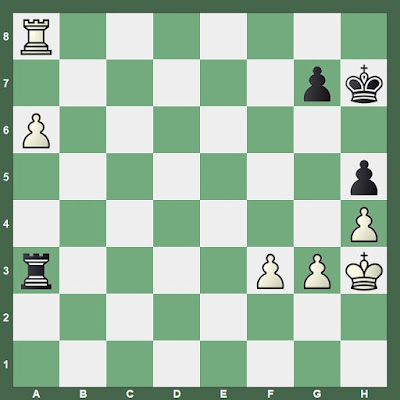Reading is central to my life. Last night, I finished John Steinbeck,
Tortilla Flat (1935) and placed an order for
In Dubious Battle (1936). I am working through all of Steinbeck's books in order of publication. Herman Melville,
The Confidence-Man: His Masquerade (1857), which I started appropriately on 1 April, is slower going.
I also read chess books and usually more than one at a time. I bought the first edition of
Dvoretsky's Endgame Manual (2003) within a year of its first publication and later acquired the second edition on my Kindle app, a second copy of the first edition in Chessbase format, and the fifth edition. Dvoretsky's book has served as an indispensable endgame resource and frequently the first of my
many endgame books that I open when I want to understand something. As I wrote in late-April, the chapter on rook endings is part of my regular work at present (see "
Working through Dvoretsky").
After racing through
300 Most Important Chess Positions (2018) in 74 days from December to March, the sequel,
300 Most Important Tactical Chess Positions (2020) has on a table in the living room, on my desk, or in a chess bag as I am beginning a slower process of working through it.
Some newer books are offering me tough choices or distractions from focus.
Think Like a Super-GM (2022) by Michael Adams and Philip Hurtado joined my chess book collection on 1 May. I took it with me on a trip that weekend (see "
Think Like a Super-GM"). When I returned home, I set up the second position on the dining room table, looked at it some with neither a note pad nor discipline and focus. I had to remove it from the table in preparation for hosting a family get together on Mother's Day.
I remain a subscriber and occasional reader of
Chess Informant, which now serves class players as well as it served masters in the days before ready access to recent games that came with the internet. I referenced an opening article from CI 162 in "
When preparation meets opportunity", showing a game where I beat a player gambling with the Budapest.
At Spring Break Chess Camp, Jim Maki was using a lot of challenging checkmate problems with the young players. In a conversation about sources for such exercises after one of the sessions, I immediately remembered
Anthology of Chess Problems, 2nd ed. (2021), a reissue of the anthology published in the 1990s by Milan Velimirovic and Marjan Kovacevic. I took it to camp the next day to show Maki, and brought it again to the youth tournament that Saturday when Maki and I were working the analysis table. It was with me during chess lessons with young players the following week. The mate in twos that begin the book are challenging enough to keep me busy far longer than I am likely to invest in the effort.
Two days ago, another book arrived that I bought not only because the topic is interesting, but also because I really liked the cover art by Kallia Kleisarchaki.
Cyrus Lakdawala takes on the task of ranking chess players past and present in
The Greatest (2025). No one will agree with his rankings, of course, because the topic remains more interesting so long as chess enthusiasts enjoy arguing with any and every list ever constructed.
Naturally, I immediately found fault with his chronology that begins with Philidor. Giulio Cesare Polerio's innovations and Gioachino Greco's improvements on those innovations remain underappreciated in chess history. Nonetheless, I find no fault either with his top four, nor with the sequence he offers. I also find his defense of the arrangement logical and compelling. Numbers five and six were the
focus of Chess Skills for two months in 2021.
After his "Classical Era Top Tier List", Lakdawala lists twenty criteria that informed his list.
The Greatest will be earning more of my attention in the coming days and weeks and I work through at least some of the 80 games that Lakdawala selected to develop the theme of chess greatness.
From time to time, I am still also working through P.H. Clarke,
100 Soviet Chess Miniatures (1963). It might be how I take my coffee in the morning if not for always playing at least two words games with my wife on our iPads--Scrabble and Words with Friends.








































